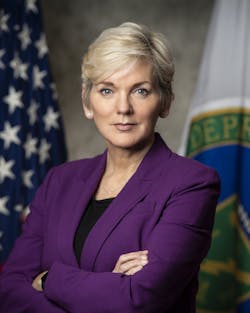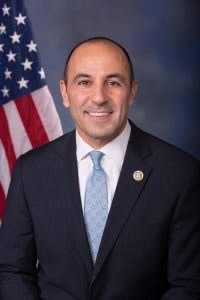But What About Microgrids? CNN Host Probes Officials
US Secretary of Energy Jennifer Granholm and other political leaders offered their insights into microgrids and the ongoing energy revolution last week during a virtual forum on resilience with CNN host Fareed Zakaria.
Jennifer Granholm, US Secretary of Energy. Photo courtesy of DOE
While the discussion touched on several energy issues, Zakaria repeatedly questioned several of the panelists about microgrids, asking about the role they can play in averting the kind of outages created by the California wildfires, February’s deep freeze in Texas and other examples of what he called “global weirding.”
“I think it is one component and an important component to have that kind of redundancy,” Granholm said. “Microgrids — that’s a technology that is available.”
She added that microgrids make particular sense for places such as Texas because it is walled off electrically from the rest of the country and California where wildfire related power outages leave swaths of the state in the dark.
How to capture a $23 trillion market
But Granholm said that she sees microgrids as only one component of a bigger plan by the Biden administration to strengthen energy infrastructure, achieve climate goals and capture clean energy jobs, a theme she repeated several times as she pitched the Biden administration’s American Jobs Plan.
Granholm described the US as being at “a critical juncture … of both crisis and opportunity. The climate crisis is certainly lapping at our shores and threatening our economy and harming our most vulnerable communities,” she said. “But on the flip side, the opportunity is that this global market for clean technologies is going to create a $23 trillion market by the end of this decade — $23 trillion. And this administration wants America to corner that market.”
As part of the plan, the Biden administration wants to add 500,000 new electric vehicle charging stations — which will place new demand on the grid and offer another good reason to buttress the macro grid, according to Granholm.
“We need to add capacity. We need to add resiliency and we need to make sure it happens, which is why the president has called for a major investment,” Granholm said. The investment could also include “the microgrids that you are talking about,” she told Zakaria. “I think microgrids need to happen, but [they’re] not sufficient in and of themselves.”
In all, the Biden administration wants to invest $100 billion to revamp the entire US electric grid, she said.
“Over the past few months, the Department of Energy has been moving at lightning speed to mobilize over one and a half billion dollars for research and development and clean energy deployment. But that one and a half billion that has been released for these kinds of technologies since I’ve been in office, that’s just a down payment for what is to come,” Granholm said
Others who spoke at the forum were US Sen. Chris Coons (Delaware); US Rep. Jimmy Panetta (California); Luke Bronin, mayor of Hartford, Connecticut; Cindy Chavez, a county supervisor for Santa Clara, California; Adrian Garcia, a county supervisor for Harris County, Texas; Lynn Good, president and CEO of Duke Energy; and KR Sridhar, founder, chairman and CEO of Bloom Energy, which hosted the online forum.
Is this India?
Zakaria asked another panelist, Rep. Panetta, about how to maintain resilience, noting: “I hear about rolling blackouts in California. I have to confess the last time I heard about rolling blackouts was when I was a kid in India. And I thought I was leaving what was then one of the poorest countries for the richest country in the world. And here I am, with rolling blackouts all over again.”
Panetta said it begins with preventing wildfires by clearing dry brush and hiring more forest service workers. But he added that it “also comes down to the question that you posed to Secretary Granholm — and that’s looking at microgrids.”
He described a town in Salinas Valley, California, that now has a microgrid after a three-day outage caused by a utility shutoff of the one transmission line to the town.
Panetta wants to see microgrids made available not only for larger entities, such as communities and hospitals, but also for homes.
To that end, Panetta has introduced a bill, the Microgrid Act, into Congress that would provide a 30% federal tax credit for microgrids.
Congressman Jimmy Panetta, author of the Microgrid Act
“Obviously in order to prevent that type of blackout, whether caused by mother nature [or] being caused by man, there’s gotta be a way to be more sufficient and more resilient. And that’s why it’s important to have microgrids,” Panetta said.
Bronin, the mayor of Hartford, Connecticut, described a microgrid the city installed with Bloom Energy technology and state support in a neighborhood with a median income of only $28,000/annually. The microgrid directly serves a library, a senior center, a neighborhood school, a community center and also has the capacity to support a nearby gas station and a grocery store during a power outage.
When asked by Zakaria how Duke Energy plans to avoid the kind of outages that Texas saw, the company’s CEO, Lynn Good, said there is never one solution.
She described vegetation and flood management, visibility into circuits, and better insight and communication on the bulk power system. “And we do believe there will be applications for microgrids where we believe that it’s the best situation versus working with the bulk power system.”
Track news about the politics of microgrids. Subscribe to the free Microgrid Knowledge Newsletter.
About the Author
Elisa Wood
Editor-in-Chief
Elisa Wood is the editor and founder of EnergyChangemakers.com. She is co-founder and former editor of Microgrid Knowledge.

